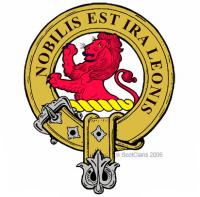
Clan Stuart of Bute
The Stuarts of Bute are descended from Sir John Stewart, born between 1345 and 1390. Sir John Stewart was the son of Robert II of Scotland and was known as 'The Black Stewart' (either for his dark complexion or because his brother, John of Dundonald was known as 'The Red Stewart'.
The lands of Bute, Arran and Cumbrae were made into a county by Robert III and Sir John was made hereditary sheriff to the lands, as set out in a Royal Charter of 1400.
James Stewart was sheriff of Bute between 1445 and 1449, being succeeded by his brother William, who was also keeper of Brodick Castle on Arran.
William's grandson was Ninian Stewart, inheriting the position of sheriff and also being created hereditary captain and keeper of the royal Castle of Rothesay in 1498. The honour is still held by the family and is represented in the Coat of Arms.
In 1539, Ninian was succeeded by his son James, who was in turn succeeded by his son John in 1570. John was Commissioner for Bute as well as being sheriff, attending Parliament in Edinburgh in this capacity.Around this time the family adopted the French spelling of the name 'Stuart', which was introduced by Mary Queen of Scots.
In 1627 Sir James Stuart of Bute was made a Baronet of Nova Scotia by Charles I.
His grandson, also Sir James Stuart of Bute was made a Privy Councilor in the reign of Queen Anne and became Earl of Bute, Viscount Kingarth and Lord Mount Stuart, Cumra and Inchmarnock in 1703. He was later made Commissioner for Trade and Police in Scotland, Lord Lieutenant of Bute and a lord of the bedchamber. In 1715 he was commander of the Bute and Argyll militia at Inveraray.
The third Earl of Bute, John Stewart, was friend and tutor to Prince George. When the prince became George III, John was made a Privy Councillor and First Lord of the Treasury. In 1763 he finalised a treaty with France, bringing the Seven Year’s War to an end.
John Stewart's heir, John Crichton-Stuart became Earl of Bute in 1792 and later 2nd Marquess of Bute. He went on to develop the docklands in Cardiff and after the Bute Docks opened in 1839, Cardiff became the world's largest coal port.
The 3rd Marquess, John Patrick Crichton-Stuart worked with the architect William Burgess on the extensive restoration of Castle Coch and Cardiff Castle.
The 7th Marquess and current Chief is Johnny Bute (known as Johnny Dumfries), who enjoyed a successful career as racing driver, winning the Le Mans in 1988.
The clan seat of Stuart of Bute is Mount Stuart. A very grand gothic mansion, it was rebuilt by the 3rd Marquess in the 19th century after being damaged by fire in 1877.









